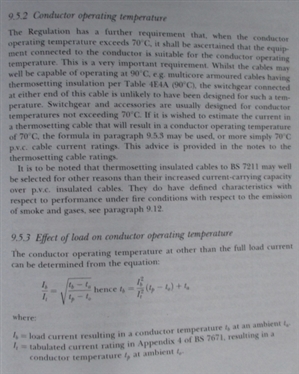Question 1: All PVC conduits in market to BS:61386 are rated for 60C operating temp while CU/PVC single core wires to IEC 60228 are rated for 70C. what is the BS 7671 point of view.
Question 2: BS 7671 section 512.1.5 states that :Switchgear, protective devices, accessories and other types of equipment shall not be connected to conductors
intended to operate at a temperature exceeding 70°C at the equipment in normal service unless the equipment manufacturer has confirmed that the equipment is suitable for such conditions, or the conductor size shall be chosen based on the current ratings for 70° C cables of a similar construction. where as NEC 110.14(c): “Conductors with temperature ratings higher than specified for terminations shall be permitted to be used for ampacity adjustment,correction, or both.” Derating factors may be required because of the number of conductors in a conduit, higher ambient temperatures, or internal design requirements for a facility. By beginning the derating process at the ampacity of the conductor based on the higher insulation value, you may not be required to upsize the conductor to compensate for the derating.is there a similar way to apply the exception of NEC using the BS 7671.

MOESEB:
CU/PVC single core wires to IEC 60228 are rated for 70C.
but would you please clarify what you mean by “that you can sometimes get a better result by taking 90 degree ratings and derating them to get a 70-degree conductor temperature than you can by using 70-degree tables directly” because I think there is a contradiction. and how one can guarantee the operating temp is 70c.
AJJewsbury:
On the face of it that sounds inconsistent, but I think the difference is accounted for by PVC having a higher thermal insulation value than XLPE
You are making a big assumption here - that there is logic behind the cable rating figures.

AJJewsbury:
There's a formula relating the derating of a cable to its conductor temperature (I don't have it to hand but should be able to dig it out if needs be) - from memory it's similar to the one for adjusting voltage drop when a cable isn't fully loaded. I'm sure I've seen it used to justify the use of 1.5mm² MICC cable on ring circuits in one of the IET books - showing that the 70 degree terminal temperature isn't exceeded.
You mean Formulas such as Neher-Magrath or that which are found in IEC-60287 or is there another formula in BS-7671.
I usually use ETAP to find actual operating temperatures of cables for Under ground systems but I can't find easy equation for another mode of installations.


AJJewsbury:
You mean Formulas such as Neher-Magrath or that which are found in IEC-60287 or is there another formula in BS-7671.
I usually use ETAP to find actual operating temperatures of cables for Under ground systems but I can't find easy equation for another mode of installations.
I've (to my shame) no idea what the formula is called or where it's originally from. I'm pretty sure it doesn't appear in BS 7671 in this form, although it does have some similarity to equation 6 in appendix 4 of BS 7671 if you strip out all the correction factors.
I've dug it out - this is an extract from the IET's Commentary on the Wiring Regulations, 16th Ed which probably explains it better than I could ever paraphrase. (it's way out of date now of course, but the underlying physics won't have changed I'm sure):
- Andy.
We're about to take you to the IET registration website. Don't worry though, you'll be sent straight back to the community after completing the registration.
Continue to the IET registration site